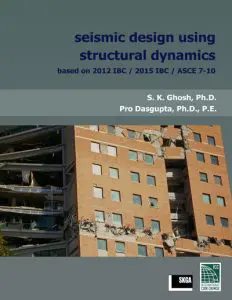
Forces on Mat Foundation from Modal Response Spectrum Analysis
Below is a recent exchange we had with an engineer who read our publication Seismic Design using Structural Dynamics and needed a few clarifications.
Q1: In the Analysis section of the book, the modal response spectrum analysis (MRSA )was used. I have a question regarding the design of the foundation when using the MRSA where all the forces (shear, moment, axial force) are positive after the modal combination is done. The base reactions do not give an indication of the locations where columns are experiencing uplift. Should the Equivalent Lateral Force Procedure be used for the design of the foundation? Or is doing an envelope of the load combinations sufficient for the design of the foundations?
A1: With MRSA, any member force obtained from an SRSS combination (or CQC) of modal forces can be considered as positive or negative. For instance, the axial force in a column obtained from the final output can be considered tension as well as compression. This is because the earthquake forces are reversible, and the axial force would be tensile when the earthquake is acting in one direction, and compressive when the earthquake reverses direction. So, when determining the design axial forces on that column by combining the seismic axial force with those from other loads (dead load, live load, etc.) through load combinations, two cases need to be considered for each seismic load combination – one where the seismic axial force is tensile and the other where it is compressive. When the seismic axial load is considered to be tensile, there may be uplift in the column. The same applies to other seismic effects (shear forces, bending moments, etc.) on a member as well.
Having said that, in the case of determining design forces for a mat foundation, the forces in all the columns being supported by the mat foundation need to be known at a given time. This information cannot be obtained from an MRSA because the result from such an analysis consists of only the maximum forces experienced by various structural members. One solution to this problem could be to perform a static analysis on the structure in order to determine the distribution of columns forces acting on the mat foundation. However, it would be preferable to perform the static analysis using the floor force distribution from MRSA instead of those from the code-prescribed equivalent lateral force method. This way, the floor force distribution along the height of the building would be more accurate and the overturning moment would be less conservative.
Q2. In the latest versions of various structural analysis software, the member forces obtained from MRSA are assigned a sign, based on their respective directions from the dominant mode (mode with the highest mass participation factor) of vibration. Is this one way to go for foundation design?
A2: The way we see it, this is essentially, if not exactly, the same as performing a static analysis using the MRSA floor force distribution, as described above. This seems to be a useful software feature when one needs information on the forces in a number of members at a given time. However, at a basic level, the very concept of having a sign associated with a mode shape is misleading, because directions of the modal displacements are completely reversible. In other words, a column could be in tension as well as in compression even when the structure vibrates in a single mode. We draw the mode shapes just to show how they look at any given instant. What is important is that the ratios of the floor displacements in a single mode remain the same all the time. Those fixed ratios constitute the shape of a mode. So, it is important that engineers realize that assigning signs to member forces is a convenient fix to a common problem with MRSA and that all member forces in the output are reversible regardless of the signs assigned to them.